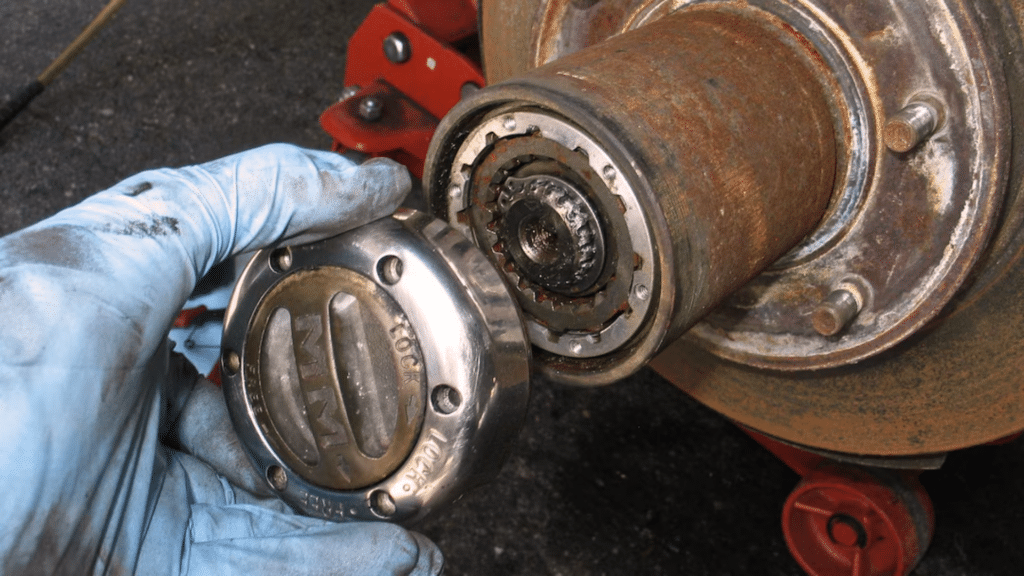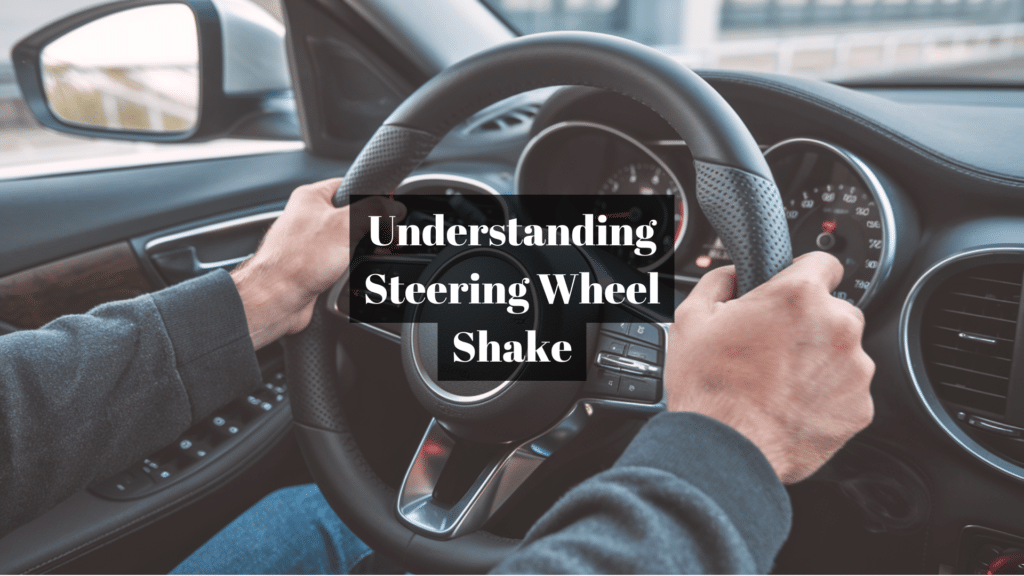Have you felt your steering wheel shake or vibrate when you press the brake pedal?
This common car problem can be quite scary, especially when it happens suddenly or at high speeds.
That shaking isn’t just annoying – it’s your car telling you something needs attention.
In this article, you’ll learn:
- The most common causes of steering wheel shake during braking
- How to tell which problem you might be facing
- Simple fixes you can try yourself
Many drivers face this issue at some point. Understanding why it happens can save you money and keep you safe on the road.
I’ve helped hundreds of car owners solve this exact problem, and I’ll walk you through everything you need to know to fix it properly.
Common Causes of Steering Wheel Shake when Braking

1. Warped Brake Rotors
Brake rotors are metal discs that your brake pads squeeze against to slow your car. When these rotors become uneven or warped, they cause vibrations.
I’ve seen this happen most often in cars that brake hard in stop-and-go traffic or after driving down steep hills.
The heat from repeated braking can change the shape of the rotors over time. You might notice this shake gets worse when you brake at higher speeds.
The steering wheel trembles in your hands because the brake pads can’t grip the uneven rotor surface smoothly.
2. Worn Brake Pads
Your brake pads press against the rotors to slow your car. When they wear down unevenly or get too thin, they can’t make proper contact with the rotors.
This creates an uneven braking force that you feel through the steering wheel.
Have you heard squeaking noises when you brake? That’s often a warning sign that your pads need replacement.
Don’t wait too long – worn pads can damage your rotors and lead to more costly repairs.
3. Wheel Alignment Issues
When your wheels aren’t properly aligned, your car doesn’t roll straight.
This puts extra strain on your braking system. During braking, this misalignment becomes more noticeable as a shake or pull to one side.
A simple wheel alignment can fix this problem and improve your tire life, too.
I recommend checking your alignment yearly or after hitting large potholes.
4. Suspension Problems
Your suspension system keeps your car stable and absorbs bumps in the road.
Worn suspension parts like ball joints, tie rods, or control arms can cause shaking.
When you brake, the forward motion of your car puts pressure on these parts, making any problems more obvious.
These issues often start small but get worse over time. If you notice the shaking gets stronger each month, your suspension might be failing.
How Brake Pads and Rotors Affect Steering Wheel Vibration?
1. Braking System
Your car’s braking system is pretty simple at its core. When you press the brake pedal, brake fluid pushes the brake pads against the rotors.
This creates friction that slows your wheels. Your rotors are metal discs attached to your wheels, while brake pads are the friction material that presses against them.
The health of these two parts greatly affects how your car feels when you brake. When everything works right, you feel smooth, steady braking.
When something’s wrong, you feel it in the steering wheel.
2. Warped Rotors and Vibration
Rotors should be flat and smooth. Over time, they can become warped or uneven due to heat from braking.
This happens because the metal expands when hot and contracts when cool. Braking creates intense heat, especially during hard stops.
When a warped rotor spins, the brake pad can’t make even contact. Instead, it jumps between high and low spots on the rotor.
This jumping action sends vibrations through the brake system, up the steering column, and into your hands.
3. Thickness Variation in Rotors
Sometimes, rotors develop different thicknesses around their surface. This happens from uneven wear or poor manufacturing.
When your brake pads squeeze a rotor with varying thickness, they create pulsing pressure instead of steady pressure.
You feel this as a rhythmic vibration in the steering wheel.
The faster you drive, the more noticeable this becomes when you brake.
4. Glazed or Contaminated Brake Pads
Brake pads can become glazed (hardened with a shiny surface) from too much heat.
They can also get contaminated with oil or brake fluid. Both problems prevent good contact with the rotors.
When this happens, your pads grab and release the rotors unevenly.
This creates a jerky braking action that you feel as vibration.
5. Caliper Problems
The calipers hold your brake pads and push them against the rotors.
If a caliper sticks or moves unevenly, it applies uneven pressure to the rotor.
This causes your brake pads to grip more on one side than the other.
I’ve found that stuck calipers often cause both vibration and a pulling sensation when you brake.
The Role of Wheel Alignment in Steering Wheel Shake
Wheel alignment refers to the angles of your wheels relative to your car and the road. Proper alignment means all four wheels point in the right direction.
When your wheels are misaligned, they don’t work together as they should.
I compare wheel alignment to rowing a boat. When all oars pull in the same direction, you move straight. When they don’t, you spin or wobble.
How Misalignment Affects Braking?
When you brake with properly aligned wheels, the stopping force spreads evenly across all tires. With misaligned wheels, some tires do more work than others.
This uneven braking force travels up through your steering system. You feel it as shaking or pulling when you press the brake pedal.
Types of Misalignment that Cause Shake
There are three main types of alignment issues:
- Toe: When your wheels point inward or outward instead of straight ahead
- Camber: When your wheels tilt inward or outward at the top
- Caster: The forward or backward tilt of your steering axis
Each type affects your car differently, but all can cause shaking during braking.
Hitting a pothole can knock your wheels out of alignment instantly. I’ve seen many cases where a driver hit one big pothole and noticed shaking right away.
The force from hitting a hole can bend components and shift your wheel angles.
This is why the shaking might start suddenly after driving on a rough road.
Simple Fixes for Steering Wheel Shake While Braking
Few driving issues are as concerning as a shaking steering wheel when you press the brake pedal. The good news is that many causes have straightforward fixes.
For the best results, address these issues promptly when you first notice the steering wheel shake.
1. Check Your Tire Pressure
Low tire pressure can cause uneven contact with the road.
I recommend checking your tire pressure once a month with a simple gauge from an auto store.
The correct pressure is listed on a sticker inside your driver’s door. Fill your tires to this number, not the maximum shown on the tire itself.
2. Replace Worn Brake Pads
Worn pads can’t grip rotors properly. You can check your pads yourself by looking through the wheel spokes at the shiny rotor.
The pad should be at least ¼ inch thick.
If it’s thinner or you see a metal tab touching the rotor, it’s time for new pads.
3. Resurface or Replace Rotors
Warped rotors need attention. Some can be resurfaced (ground down to be smooth again), while others need replacement.
I usually recommend replacement if the rotor is deeply grooved or has been resurfaced before.
New rotors often cost $30-100 each, plus labor.
4. Balance Your Wheels
Unbalanced wheels shake at certain speeds. A tire shop can check and balance your wheels in about 30 minutes.
They’ll add small weights to offset heavy spots in your wheels.
This typically costs around $40-80 for all four wheels.
5. Get a Wheel Alignment
Misalignment causes uneven tire wear and shaking.
After hitting big potholes or every 2-3 years, get your alignment checked.
The technician adjusts the angles of your wheels to factory specifications. This service usually costs $70-150, depending on your car.
How to Prevent Steering Wheel Vibration in The Future?
Steering wheel vibration can turn an otherwise pleasant drive into a stressful experience. Taking preventive steps helps you avoid this problem and the costly repairs that often follow.
These practical measures will keep your steering wheel steady and your driving smooth.
1. Follow a Regular Maintenance Schedule
Prevention beats fixing problems later. I recommend keeping a simple maintenance log in your glove box to track when services are due.
Write down the date and mileage for each service you get. This helps you stay on top of maintenance and spot patterns if issues return.
2. Change Your Braking Habits
How you brake affects your brake parts. Try to slow down gradually instead of slamming on the brakes whenever possible.
This gentle approach reduces heat buildup that warps rotors. When you see traffic slowing ahead, ease off the gas early before braking.
3. Rotate Your Tires Regularly
Even tire wear prevents vibration issues. Have your tires rotated every 5,000-7,000 miles or with each oil change.
This simple step costs little but saves money on premature tire replacement. It also helps maintain even braking performance.
4. Check Tire Pressure Monthly
Proper tire pressure is key to smooth braking. I check my tires on the first day of each month as an easy reminder.
Underinflated tires flex too much and create uneven wear patterns. They also make your car less stable during braking.
5. Address Road Salt and Grime
Salt and road grime can damage brake components. In winter areas, wash your car’s underside regularly to remove corrosive materials.
Pay special attention to your wheel areas where brake parts live. A clean braking system lasts longer and works better.
6. Listen to Early Warning Signs
Your car often gives hints before major problems develop. Pay attention to new sounds, feelings, or behaviors when braking.
Squealing, grinding, or light vibrations are early warnings. Fixing these small issues prevents them from becoming big, expensive problems.
7. Choose Quality Parts for Repairs
Not all brake parts are created equal. When replacing components, I suggest using original equipment quality or better.
Cheaper parts might save money initially but often wear faster and cause problems sooner. Quality parts typically last twice as long.
When to Seek Professional Help for Steering Wheel Shake?

While some minor steering wheel issues can be addressed with DIY solutions, certain situations call for professional attention.
Knowing when to visit a mechanic saves you time, money, and potential safety risks.
When Vibration Persists After Basic Fixes
If you’ve checked tire pressure and had your wheels balanced but still feel shaking, it’s time for expert help.
I’ve seen many cars where the problem was more complex than it first appeared.
Don’t keep driving with persistent vibration. The problem often gets worse and can lead to more expensive repairs later.
If You Hear Grinding Noises While Braking
Grinding sounds mean metal is rubbing on metal. This might be brake pads worn down to their backing plates.
This situation needs immediate attention.
Driving with grinding brakes damages your rotors and can lead to brake failure.
When the Car Pulls to One Side While Braking
If your car veers left or right when you apply the brakes, something is wrong with your braking system or alignment.
This is unsafe and needs fixing.
The pulling indicates uneven braking force, which a professional can diagnose with specialized equipment.
If the Brake Pedal Feels Different
A soft, spongy, or pulsating brake pedal paired with a steering shake means there could be air in the brake lines or other serious issues.
Changes in how your brake pedal feels should never be ignored.
These symptoms often point to problems with your master cylinder or brake lines.
When the ABS Light Comes On
Your Anti-lock Braking System (ABS) light warns of system problems. If this light is on and you feel shaking, your car needs a computer diagnosis.
Modern cars need special scanners to read the error codes.
This is not something you can check at home without proper tools.
Conclusion
Steering wheel shake during braking usually comes from worn brake parts, alignment issues, or tire problems.
By checking your tire pressure, rotating tires regularly, and replacing worn brake components when needed, you can often fix the problem yourself.
Regular maintenance is your best defense against future shaking.
Simple steps like gentle braking habits and periodic inspections can save you money and keep your car running smoothly.
Remember, many of these fixes are straightforward but don’t hesitate to see a professional if the shaking continues or gets worse.
Your safety on the road depends on properly working brakes. Taking care of small issues now prevents bigger problems later.
Frequently Asked Questions
Is Steering Wheel Shake Dangerous While Driving?
Yes, it can be dangerous as it might indicate brake problems that could fail in an emergency. Don’t ignore this warning sign from your car.
Can Worn Suspension Cause Steering Wheel Shake Even when Not Braking?
Absolutely. Worn shocks, struts, ball joints, or control arms can all cause your steering wheel to shake, especially on bumpy roads.
How Much Does It Typically Cost to Fix Steering Wheel Shake?
Costs range from $40 for a tire rotation to $500+ for complete brake work, depending on the cause and your specific vehicle model.


